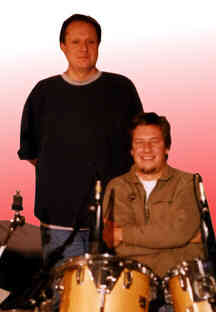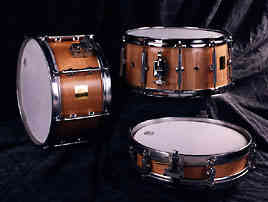
|

|

March 1997 |
| Cover Story | Columns | Features | Reviews | Reference | Contact Info |
|
Drum Designer Mitch Greenberg
with Greg Marsh
How'd you get started building drums? I started playing drums when I was eight, and started building them when I was 10. I filled a lot of school notebooks with designs we're still using. It's something I've always done. So I've been designing and building drums since the ‘60s. I started Bison officially about seven years ago. The most famous Bison drum is probably the Volcano (ed note: the Volcano has a 14" top head and a 15" bottom head; the shell tapers slightly). That idea started in 1970. I was playing tabla in the ‘60s, back when Ravi Shankar was hip -- the Beatle's imitation stuff and all that. I had the image for the drum in my mind. I knew there was a sound there that I could get out of a double-headed drum with wires across the bottom. Bob Levine had a chart on how to apply Indian drumming to Western rock and roll. We prototyped the first one out in California. We took an old Trixon shell, cut it up, and turned it around. That's the prototype that Paul Wertico still has -- the first one we made functional. We didn't get the patent on it until 1993. We applied for it and got it right away --nearly the reverse of how it usually happens. It was Paul playing the first one at the Jazz Bulls Nightclub that I realized how good it really was. I could hear every note, [including] all the fancy left hand stuff; it was all very clear and crisp, despite the awful acoustics. I knew we should patent it then, but we couldn't figure out how to do the lathing on the smaller head size -- the bullet necking -- for nearly 10 more years. Are they difficult to manufacture? Yeah, we generally farm out the lathing and the gluing, too, usually. The first ones were made from laminate and the later ones were turned out on a lathe. They're made from staves -- similar in concept to the way a barrel is put together. It has to be a lot tighter than a barrel, obviously. It works like a bell of a trumpet. If you had a trumpet that ended in a straight diameter tube, one note would be very loud, it would kind of chime, but the others would be much lesser volume. Because the heads are almost like speakers, they're working on an inverted process from the trumpet bell in that they're loading their response over a spreading harmonic band. It's a simple thing in terms of the physics. It's a little like a nozzle on a rocket; it disperses pitching frequencies. Megaphones use a similar principle, too. It's simple physics, really, but nobody ever thought of putting skins on it. When we put it together, it actually worked better than we thought it would. Have you thought of making Volcano toms or a full kit? I don't feel there's a unique enough sound we would be getting out of that. What other ideas are you working on? We're putting out drum sets with magnesium alloy hoops. They're about a half-inch thick and really change the response of the drum. They have that brushed-chrome look? Yes, we can't really polish them. That's a Bison idea? Yes, I designed the molds. We're on our sixth foundry; it's very problematic. Foundries are not used to holding those types of tolerances, with that type of pour, and especially with that alloy. It's a very difficult alloy to work with. The result is the only guaranteed-for-life hoop on the market. It's 10 times stronger than anything that's ever been made. The advantage is precision tuning. We cast it, then grind it, so it's absolutely flat and true. Its structural vibration identity is going to run through the drum. It tightens the whole drum and changes which parts of the drum resonate. No matter what the tension, the upper-middle frequencies are huge. All sorts of impact and surface sounds that aren't heard with conventional hoops are heard with these. Do you use them just on the top head? I think they work better on the top and the bottom -- they're more balanced that way. Uh, they sound very expensive... It takes seven processes to get them ready. Machining, counter-boring, grinding the bottom, grinding out the collar where it slips over the shell, and the finish work. The bottom hoops have to have the gates for the snares carved through. It's all done by hand. Uh huh. Okay, how much for one 14-inch snare hoop? In the $150 neighborhood. Is it worth it compared to the other stuff on the market? Yeah. Do those hoops come stock on any Bison drum or is that a special order add-on item. They can't be interchanged. So the drum has to be ordered with them. But it's a stock drum, we have about 10 models that have it. Doesn't Bison also have the magnesium alloy bass drum beaters too? No, they're made of titanium. That idea is nearly older than the Volcano. I understood it and what had to be done with that around 1975. We cost-bid it out. It seemed like the easiest project to get out, but the one most likely to be stolen by another company. So I decided to go after the snare drum project first. You can attach any type of beater on the titanium shaft. We actually guarantee that it will improve your playing. How many different models of drums does Bison have? Thirty-five snare drums, or so. All hand made? Well, some parts are machined, but essentially they're hand made. We don't crank out 100,000 parts at a time. The shells come from the same furniture company that DW and Pearl buy their high-end maple shells. They're very precision. The shells are built to within very tight tolerances, usually within a 32nd of an inch. And our fittings demand close-tolerance work, as well. It's not so much that it’s "handmade" I suppose -- but the attention to detail is extreme.
Yes. Germany's bought several hundred. The United States has bought just about as many. They're in Johannesburg, Oslo, Tokyo -- all over. I don't always know who the end-user is, since sometimes they go through distributors and dealers. We have about 10 dealers in the United States alone. What about other drums and different types of equipment? We're just finishing up a run of symphonic bass drums. Thirty-two and 36 inch drums, suspended, with animal hide drum heads and humidifiers and dehumidifiers. We've toyed with the idea of doing orchestra bells, but nothing solid yet. I've come to you for a lot of miscellaneous parts and pieces. You're a hardware expert, particularly on rare and hard-to-find equipment. You have a ton of parts. Probably five tons! We have parts dating back to the civil war era at the Drum Center. But you could have 10 times what we have and still not have it all. Over the years, I've developed a network of people around the country. I can call to find parts I don't have in stock. How did you get the parts to begin with? I used to buy other stores -- basements of stores with repair services, in particular. I used to drive to the Dakotas, Minnesota and Iowa. Milwaukee had 27 music stores at one time. I used to break the shocks of the truck bringing it all home. I probably bought up the basements of half of them. Didn't you help Buddy Rich put together a vintage set? I gathered the parts to make three whole Radio King drum sets, like he played in the ‘40s. Joe McSweeney from Eames Drums refinished them in the original white marine pearl. We shipped them off to Buddy. He played them the last few years of his life -- he wanted to get back to playing his old set. The Smithsonian in Washington has one of the sets I put together for him. Are you still playing gigs? No, not anymore. I played from when I was about twelve until about 37 or so. I'm just not that attracted to losing my Saturday nights anymore. I like the manufacturing thing -- you turn out the lights, you walk out the door, and you've got a social life. I'm a little too lazy. I like to do the work and have sit down for a while! For more information about Bison drums:
Bison Drum Company
Don't miss the new Percussion Discussion web site at http://www.webxfm.com/drums. Click for back issues and other goodies!
|

| Cover Story | Columns | Features | Reviews | Reference | Contact Info |
All material Copyright 1997 by Sam T. Publishing, Transgalaxy Productions, and its respective owners. This site designed & built by Transgalaxy Productions , hosted by JustNet, the best damn ISP around.

